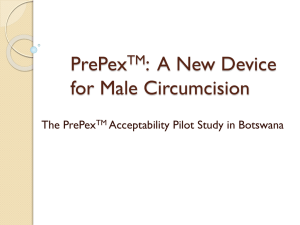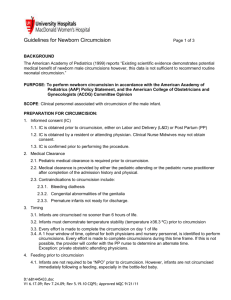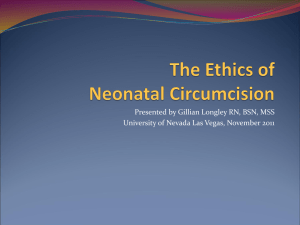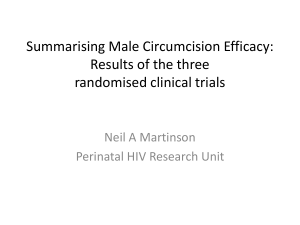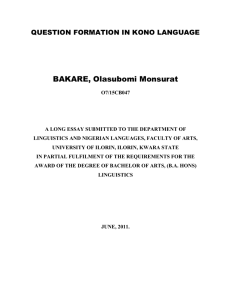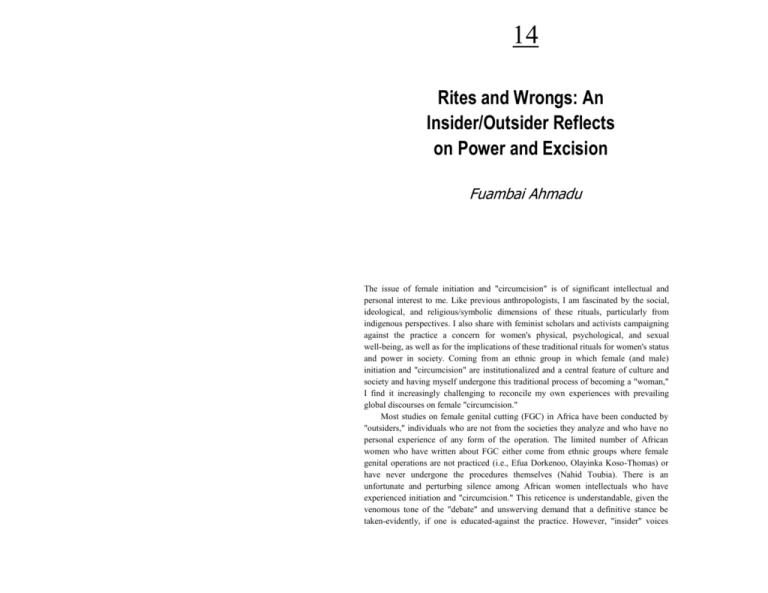
14
Rites and Wrongs: An
Insider/Outsider Reflects
on Power and Excision
Fuambai Ahmadu
The issue of female initiation and "circumcision" is of significant intellectual and
personal interest to me. Like previous anthropologists, I am fascinated by the social,
ideological, and religious/symbolic dimensions of these rituals, particularly from
indigenous perspectives. I also share with feminist scholars and activists campaigning
against the practice a concern for women's physical, psychological, and sexual
well-being, as well as for the implications of these traditional rituals for women's status
and power in society. Coming from an ethnic group in which female (and male)
initiation and "circumcision" are institutionalized and a central feature of culture and
society and having myself undergone this traditional process of becoming a "woman,"
I find it increasingly challenging to reconcile my own experiences with prevailing
global discourses on female "circumcision."
Most studies on female genital cutting (FGC) in Africa have been conducted by
"outsiders," individuals who are not from the societies they analyze and who have no
personal experience of any form of the operation. The limited number of African
women who have written about FGC either come from ethnic groups where female
genital operations are not practiced (i.e., Efua Dorkenoo, Olayinka Koso-Thomas) or
have never undergone the procedures themselves (Nahid Toubia). There is an
unfortunate and perturbing silence among African women intellectuals who have
experienced initiation and "circumcision." This reticence is understandable, given the
venomous tone of the "debate" and unswerving demand that a definitive stance be
taken-evidently, if one is educated-against the practice. However, "insider" voices
from initiated/"circumcised" African women scholars can go a long way toward
providing fresh approaches to our understanding of these practices and their continued
significance to most African women.
184
FEMALE “CIRCUMCISION” IN AFRICA
In this chapter I attempt to reconcile "insider" representations with "outside
perspectives. I seek to contextualize my own experience within the broader framework o
initiation in Sierra Leone's Kono society and then contrast dominant Kono paradigm
with conflicting international debates that focus on female "circumcision" as a peculia
manifestation of women's global subordination.
My main quarrel with most studies on female initiation and the significance o
genital cutting relates to the continued insistence that the latter is necessarily "harmful" o
that there is an urgent need to stop female genital mutilation in communities where it
done. Both of these assertions are based on the alleged physical, psychological, and sexu
effects of female genital cutting. I offer, however, that the aversion of some writers to th
practice of female "circumcision" has more to do with deeply imbedded Western cultur
assumptions regarding women's bodies and their sexuality than with disputable healt
effects of genital operations on African women. For example, one universalize
assumption is that human bodies are "complete" and that sex is "given" at birth.'
second assumption is that the clitoris represents an integral aspect of femininity and has
central erotic function in women's sexuality. And, finally, through theoretical extensio
patriarchy is assumed to be the culprit-that is, women are seen as blindly an
wholeheartedly accepting "mutilation" because they are victims of male politica
economic, and social domination. According to this line of analysis, excision is necessar
to patriarchy because of its presumed negative impact on women's sexuality. Removal o
the clitoris is alleged to make women sexually passive, thus enabling them to remai
chaste prior to marriage and faithful to their husbands in polygynous households. Th
supposedly ensures a husband sole sexual access to a woman as well as certainty of h
paternity over any children she produces. As victims, then, women actively engage i
"dangerous" practices such as "female genital mutilation" (FGM) to increase the
marriageability (see, for example, Chapter 13 of this volume), which would ultimate
enable them to fulfill their honored, if socially inferior, destiny of motherhood.
When attempting to reconcile Kono practice with dominant anti-FGM discourses,
number of problems arise, starting with the alleged physical harm resulting from th
practice. Part of the problem, as Bettina Shell-Duncan, Walter Obungu Obiero, an
Leunita Auko Muruli lucidly argue in Chapter 6 of this volume, is the unjustified
conflation of varied practices of female genital cutting and the resulting overemphasis on
infibulation, a relatively rare practice that is associated with a specific region and
interpretation of Muslim purdah ideology.' Kono women practice excision, the removal o
the clitoris and labia minorae.3 As several contributions to this volume suggest (se
Chapters 1, 5, and 6), the purported long-term physical side effects of this procedure ma
have been exaggerated. It can be argued, as well, that although
286
FEMALE "CIRCUMCISION" IN AFRICA
and Freetown talking to Kono refugees and women activists, mainly about their mor
immediate survival concerns but also about "circumcision," initiation, and the future o
women's secret societies. These discussions included informal interviews as well a
formal semistructured interviews with three ritual officials: two traditional circumciser
or Soko priestesses, and one digba, or ranking assistant to the Soko.
The cumulative data are drawn from interviews with a broad range of Kono me
and women: young, old, university-educated professionals in Freetown and in the Unite
States, as well as illiterate villagers and traditional rulers in Kono. If I have sacrifice
quantification, it has been for the benefit of collecting detailed qualitative data that wou
enable my search for meaning and significance, both of which I felt could be be
obtained through carefully selected, knowledgeable informants. What this study attemp
to explain are the views, beliefs, and rationales of supporters of initiation an
"circumcision." The extent to which these attitudes reflect those of all or the majority o
Kono women is left open for future research.
My specific aims in this chapter are, first, to elucidate the significance of fema
initiation and "circumcision" in terms of indigenous Kono cosmology, culture, an
society and to demonstrate how and why it is that bodily operations-both male an
female-are viewed as necessary and important processes in the dynamics of sex an
gender constructions and kinship relations. My second objective is to interrogate specif
areas relating to international discourses on eradication of female "circumcision," usin
my own personal experience as well as Kono ethnographic data and the accounts of th
experiences of individual Kono women. Finally, my goal is to discuss avenues fo
compromise on the "debate" about female "circumcision" and to suggest alternativ
strategies to current hard-line approaches.
Background to a Practice: Kono
Cosmos, Culture, and Society
The Kono are a Mande-speaking people who, according to oral historical accoun
migrated from the Guinea savannah region toward the end of the Mali Empire to th
current home in northeastern Sierra Leone.' Kono is also the name of their geograph
location and their common language. Most Kono uphold indigenous religious belie
although a minority proclaim Islam, and even fewer profess Christianity as their domina
faith. The subsistence economy is based on agriculture, with rice being the main cro
Diamond mining has had a major, if not disastrous, impact on Kono economy, culture, an
social life. Today intense civil war rages in the diamond-rich areas (see Richards 1996 for
analysis of the full complexities of Sierra Leone's "bush war"). This conflict has driven o
virtually all peasant farmers from their vil-
288
FEMALE “CIRCUMCISION” IN AFRICA
felling trees and brush, and for sowing rice and plowing it into the ground. Althoug
men "control" the land, they depend on the labor of women to snake it productive, an
the latter can withhold their services if they have particular grievances that need to b
aired and resolved. Whereas in agriculture, men control the end product of the harves
in indigenous cloth production women own and control the finished goods (Hardi
1993:135). As only men are permitted to weave, however, strict sexual interdependence
maintained in this area of production as well. There are certain "sacred" sectors o
production that are exclusively male and exclusively female, such as blacksmithing (male
and ceramic pottery (female). Today, however, dramatic changes in the modern econom
are resulting in women clearly becoming more and more economically and sociall
disadvantaged. Women are becoming more dependent on men for their survival a
diamond mining and cash cropping and the increasing importance of cash as primar
medium of exchange have led to a decline in the demand for goods traditional
produced by women.
Ritual Initiation in Kono
Initiation of girls into Bundu and boys into Poro takes place during the dry season, afte
the harvest, when food is plentiful and there is a significant amount of free time. This tim
of year is also symbolically important because it represents a new season of fruitfulness
fertility, abundance, and the possibilities of new life just as initiation seeks to give birth t
new, fertile, culturally transformed young women and men. Thus, symbols of agricultura
production and human reproduction are synthesized and given powerful meaning i
initiation; but also initiation finds its meaning and justification in the performance o
everyday farm work and sexual relations, both of which are defined in terms of female an
male separate yet complementary contributions. The women's Bundu society and th
men's Poro are severally responsible for the "creation" of female and male sociocultura
beings from the raw material of nature, young children. Although some authors hav
stressed the symbolic negation of female reproductive powers by men, usually in referenc
to male initiation (e.g., Bloch 1986; Herdt 1982), it is important to note that for the Kon
(and I suspect, for other initiating/genital cutting groups as well) what is negated is th
biological reproduction by both male and female human beings, and what triumphs i
initiation is the cultural creation of sexual and gender identity through the ritual proces
and the important intermediary role of the priest or priestess (as in the case of the soko
The imagery of female reproduction is central to the ritual creation process. Afte
undergoing a symbolic death, young initiates enter a metaphorical womb, the sacre
grove, where they are circumcised-thus given an unambiguous sex-and then remain in
liminal state while they receive ritual instruction. They are ritually
290
FEMALE “CIRCUMCISION” IN AFRICA
have been more excited as well as afraid. My younger cousin and sister also looke
forward to the promised feasting, gifts, and celebrations, as well as their first trip to the
ancestral homeland.
Our first week in Freetown was spent visiting relatives who welcomed u
congratulated us for coming, and gave us gifts and their blessings. We then travele
upcountry to Kono, where both of my parents grew up. Our first stop was in Koidu, th
capital of Kono, where my mother's sisters resided. Hundreds of close and distan
relations came out to greet us, sing and dance, and honor our arrival and the upcomin
"occasion." After several days, we traveled to Ghandhoun, my mother's patrilineal villag
to pay tribute to my grandfather's tomb. He had passed away four years before. In th
presence of the entire town, including fourteen of my grandfather's twenty-plus wive
my grandfather's spirit was assured that we had been brought back "home" from Pu
(the white man's country) to carry on the traditions of our people and that his form
blessing was being sought. I was later told by a cousin that the selection of the soko1
and the ritual "crier" (whose voice drowns out those of the initiates durin
"circumcision") also took place at this time.
After the greater part of "initiation business" (location, leaders, musicians, foo
preparation, and so on) was sorted out by the women, my sister and I were drive
through thick forests and rough hills to my father's birthplace, Bomanjah. We wer
greeted by my father's relatives, and my mother was thanked again and again for bringin
us. Later in the afternoon, everyone gathered in a clearing at the village center. Prayer
and libations of cooked rice and fowl were offered to my father's lineage ancestors. Also
representatives were selected to attend and participate in the ceremonies in Koidu.
We returned to Koidu the following morning after traveling the entire night. Th
town was busy with arrangements and preparations for the "dance." I tried intently to
observe everyone, every action and event taking place, although it was categoricall
understood that I was not to ask questions at this stage. I was concerned about my littl
sister, but she was enjoying being the center of everyone's attention. I "knew" what wa
going to happen to us, but I couldn't bring myself to tell her-perhaps like my mothe
could not bring herself to tell me, in her own words, "from her own mouth"-for fear o
making her afraid as well. In any case, I was truly fascinated and overwhelmed by such
radically new experience. I reasoned that whatever it was I was going to endure, it woul
be worth the experience, the excitement of watching and being involved in the dram
around me.
There was a sense that "it" was approaching. At some point we, the initiates, wer
isolated from everyone else. This seemed to mark the "beginning." I was more on
constant alert than I was frightened. I did not want to miss anything. My female
cousins/assistants were all very supportive, and I let their eyes and expressions guide m
own feelings. I asked them about the pain and whether I would ever enjoy sex again, and
they laughed. One very pretty
292
FEMALE “CIRCUMCISION” IN AFRICA
their representatives had offered a substantial amount of' money to the "guardian spirit
Finally, I was grabbed by a different woman-extremely beautiful, elegant, almo
regal. She walked my exhausted body away from the crowd, which followed behind. Sh
explained that she was a dear friend of my mother's, that she was there to help me and
take care of me, and that she had lived and traveled extensively in Europe and the Unite
States, so she understood what a culture shock this experience must be for me. Sh
reassured me that my mother was okay, but that she could not be around until later, an
that I should not worry because we were all in very good, skilled, and capable hand
"This is our culture," she repeated to me over and over again. The dreadful white-painte
"guardian spirit" showed up again, trying to take me away in order to get more mon
from my father's relations, but my new "mentor" berated her and sent her away.
Later that evening-and I felt as if every moment was being closely timed-I was tol
by another close friend of my mother's, a registered nurse, what the "circumcision" rit
entailed. She said she would give us an anesthetic injection to thwart any immediate pai
and that she would also administer oral painkillers and antibiotics to prevent further pai
and infection after the operation. She also pointed out that those of my relations amon
the audience who were medical doctors were on full alert and that there were clinic
close by in case of any emergencies. I was suddenly struck by the full extent of what
had allowed myself to get into. Also, I realized that her revelations were against the "cod
of silence"-yet she felt obligated to inform me of what was happening, perhaps because
was a full-fledged adult or because I had been brought up in Puu.
We were given more "medicines," bitter-tasting, moist leaves. The celebrations wen
on while we were secluded inside the house. I was feeling increasingly "high" an
paranoid and suspected the not-so-innocuous-looking "medicines." None of us wer
permitted to sleep, but we were interrupted every few minutes or so to participate in thi
or that prayer, blessing, or libation. At about two or three o'clock the following morning
we were made to strip by the elderly women "guarding" us. Our nether regions wer
shaved and we were given different lappas to wear. My mother appeared, her face visibl
worn and drawn, and then she disappeared. An hour or so later, the noise died down.
We were rushed out, surrounded by dozens of unfamiliar older women, to anothe
house a few yards away. We were made to sit up on the dusty cement floor, more and
more women filtering in after us, one by one taking up every corner in the small room
until there was no more space. Suddenly there was a knock on the door. I looked over a
my sister and little Sia, both lying motionless on the ground, propped up by older women
sitting among them. My mother came in with some other women, and I could see in he
worried
294
FEMALE “CIRCUMCISION” IN AFRICA
always flanked by several other female elders. I found out later that she was our soko, th
well-respected and revered excisor. Her entire reputation, her renowned surgical skil
her supernatural abilities, even her alleged sacred knowledge were all being tested durin
our excision rite. Not only were we, the initiates, the direct descendants of the rulin
family in Ghandouhn, but we had come all the way from Puu. In these rapidly changin
times of so-called development and modernization, the sokos are well aware of the thre
to their power and authority and, worse, the challenge to their way of life and value
traditions. It was during this time, when the pain had subsided and I was assured b
Bundu officials as well as by cousins my own age that my operation would in no w
inhibit my sexuality, that I became relaxed enough to start inquiring into the historic
relevance of initiation and why it remains important to contemporary women.
It is this older generation of women, particularly those within the Bundu tradition
hierarchy, who are arguably the immediate and direct beneficiaries of female excisio
rites. However, from these women and the rituals they promulgate, I have learned t
question my steadfast beliefs and values as a "Westernized" woman. Women of m
mother's generation and now my own must weigh the benefits of such traditions agains
increased international concern about its physical, psychological, and sexu
consequences for women. Ultimately, it is up to each generation of women to decid
whether to continue or to reject this tradition without fear and coercion from outside a
well as inside.
The Significance of Genital Cutting
What is the significance of such a ritual that, as described above, can be very painful and
entail medical and other risks for initiates? Above I briefly examined the dual-se
structure of Kono society as a backdrop to an analysis of the relevance of female (and
male) circumcision. In this section, I put aside for the moment health, sexual, and
psychological issues raised by outside observers and activists against FGC, in order to
consider in greater detail possible explanations and rationales for the tradition in terms o
Kono worldview, dominant gender ideologies, the systemic and political influence o
female ritual leaders, and, finally, individual motivations. First, I consider indigenou
constructions of cosmology to the extent that these can be guessed at from documented
mythologies of neighboring peoples with similar traditions and institutions. Second,
analyze local ideas regarding nature and culture and how these impinge upon human
bodies and cultural constructions of sex and gender. I also consider dominant idea
regarding reproduction and sexuality and the rationale these suggest for genital cutting
Third, I discuss the ideological ramifications of female "circumcision" and its link to
"matriarchal"
296
FEMALE “CIRCUMCISION” IN AFRICA
mythology that depicts primordial females (inadvertently) excising themselves (usual
through youthful masturbation) suggest some striking similarities to the Dogon story an
a possible cosmological basis for explicit indigenous perceptions of the clitoris as a
inherently masculine organ. Marilyn Strathern (1987) also postulated an "androgyny
theory to explain genital modifications among the Hagen of Papua, New Guine
According to Strathem, indigenous views of the cosmos explain how persons are bor
"complete," that is, each individual contains both masculine and feminine elements a
birth. Initiation is meant to engineer the deconstruction of persons into "incomplete
halvesmale or female-who would then be capable of reproduction."
However, the suggestion that the Kono may hold certain deep-rooted belief
regarding the religious origin and necessity of female (and male) circumcision does no
explain why the practice prevails today, particularly since local rationalizations are rarel
alluded to on this level. Moreover, the fact that the layperson cannot recall suc
mythologies or stories about the cosmos or creation is further reason to consider othe
local justifications and motivations for initiation and "circumcision." Also, suc
worldview explanations that justify genital operations could rightly be interpreted as loca
ideological rationalizations that ensure the social status quo and the dominance of on
group over another (e.g., Herdt 1982; Bloch 1986; see also Chapter 7 of this volume). I
the case of the Kono and female "circumcision," as I will later demonstrate, ideologica
dimensions of female rituals ensure the power and preeminence of older women ove
younger women as well as over men in society. Nevertheless, myths are importan
because they point to origin and meaning (Bachofen 1967:70), however much histor
imposes its own distortions and reinterpretations (Bloch 1986:10-11). Also, the questio
of origin is becoming increasingly important, particularly to African women who uphol
the tradition and are continually finding themselves in a position to justify the practice t
outsiders and, perhaps more so, to themselves.
Nature, Culture, and "Sex" Categories
Principles of sexual complementarity and interdependence that underlie fragmented
constructions of Kono cosmology and mythology are also evident in more accessibl
cultural notions of sex and gender and the practice of sexual operations. Unlike Western
cultures, which divide human bodies into two sex categories, "male" and "female,
believed to exist outside culture and therefore "natural" and immutable, the Kono have
different ontological understanding of bodies: only infants and very young children ar
conceived of as "natural," ontologically prior to "culture," or "proto-social," a
MacCormack remarked for the Sherbro concept of children in southern Sierra Leon
(MacCormack 1980:95). Like other areas that fall into the category of "nature," such a
the "bush" or forest before being cleared or "tamed" and "made" into
298
FEMALE “CIRCUMCISION” IN AFRICA
ering that she can sexually stimulate herself or be manually stimulated by othe
(including other females), does not desire or seek vaginal penetration by a man's pen
The clitoris is seen as parallel to the penis of a prepubescent boy-both have erotic but
reproductive value. However, according to a ritual informant, a young boy develops in
an adult man, and his penis enlarges and acquires procreative value, whereas in mo
cases the clitoris remains relatively diminutive in size, incapable of penetration, and th
can neither sexually satisfy nor impregnate another woman. In short, the clitoris
analogous to a dysfunctional penis where women's reproduction and (hetero)sexuality
concerned. Thus, excision can be interpreted metaphorically and physiologically as
eschewal of undeveloped, inhibiting masculinity.
Female Ideology, Authority, and Power
However, inasmuch as a culture's sex and gender models and beliefs about reproductio
and sexuality can make sense of cultural practices such as genital modifications, they a
still inadequate in accounting for the widespread continuity of these practices. Thus far,
have presented Kono ideologies as if these existed in a cultural vacuum, isolated fro
contact with outside groups and external influences that may promulgate conflictin
practices and beliefs. As noted earlier, dramatic changes have occurred, particularly with
economic sectors, that have uprooted traditional life and precipitated permanent shifts
Kono society. Young Kono women, drawn to urban mining centers, are heavi
influenced by new, "global" culture defined by American hip-hop, Coca-Cola, "gangst
videos, and classic action-packed films such as Rambo (again I recommend Richards 199
for an account of postmodern youth culture and the bush war being waged in Sier
Leone). Many young women are actively engaged in war, primarily as rebel recruit
exposed to and themselves committing some of the worst human atrocities in rece
international history. Other Kono women have traveled, been schooled and spent mo
of their lives abroad. Some are national political leaders having to come to terms wi
heated issues such as the small yet vocal war being launched internationally to end fema
"circumcision." In this section I discuss the remarkable degree of continuity still found
practices of initiation and "circumcision," despite these broader changes brought on b
modern developments.
Among the Kono, as Hardin has observed, power (gbaseia) involves above all th
ability to "harness knowledge, medicines, witchcraft, and other supernatural means in
socially appropriate ways" (Hardin 1993:192), and Bundu and Poro are the ultimat
embodiments of female and male power, respectively. There can be no adequat
understanding of the compelling force of initiation and "circumcision" without an
appreciation of women's power and influence in Kono society even today. The social and
cultural imperative to initiate and "circumcise" one's daughter is expressed top down
through hier-
300
FEMALE “CIRCUMCISION” IN AFRICA
lineages. 1b In the first instance, vis-a-vis female elders-that is, within their own s
group-initiates and younger women are inferior. However, crosssex status compariso
would violate local dual-sex models, which emphasize complementarity an
interdependence through sexual difference and autonomy. In the second instanc
vis-a-vis their husbands and their male (and female) lineage representatives, you
novices are taught to feign subservience-in verbal communication, body language an
gestures, and the performance of domestic duties-in order to live harmoniously amo
their affines. But ritual leaders do not only teach subservience. They themselves a
examples of ultimate female authority: wise, unyielding, and unsentimental. It is t
soko's responsibility to see to it that novices are inculcated with the ideals of femininity
laid down by previous ancestresses: stoicism, which must be displayed during excisio
tenacity and endurance, which are achieved through the many other ordeals a novice mu
undergo; and, most important, "dry-eye," that is, daring, bravery, fearlessness, an
audacityqualities that will enable young women to stand their ground as adults in the
households and within the greater community. Thus, the soko has a paradoxic
responsibility of "creating" dual-natured "woman": a community-oriented and subservie
person to be exchanged in marriage, as well as a defiant individual who capitalizes on t
bolder qualities ingrained in her feminine identity in defending her own goals, prioriti
and stakes within society.
Mothers: Upholders of Tradition
Female elders flank the upper echelons of Bundu. The next and most important categor
of women as far as the continuation of initiation and excision is concerned are th
middle-aged grandmothers, whose critical job it is to put pressure on their daughters, wh
may be wary young mothers. These eminent elders have significant moral and emotion
control over their married daughters. New mothers often spend a great deal of time i
their natal villages under the supervision of their own mothers, particularly after the birt
of and throughout the weaning period of their children. This group of older women ar
well aware of their importance when it comes to initiation and are often the one
spearheading the organization and orchestration of their granddaughter's ceremonies. It
incumbent on mothers to initiate their daughters properly, according to ancestral custom
in order for the latter to become legally recognized as persons with rights an
responsibilities in society. Thus, there is enormous cultural demand for mothers t
conform to the tradition of initiation, no matter how far their travel, the length of the
absence from their local communities, and for those who are abroad in Europe or th
United States, the intensity of their "Westernization."
For Kono women living in the diaspora, there is not much difference because many
remain very close to their mothers. Although older women and
302
FEMALE “CIRCUMCISION” IN AFRICA
war, and so on. Kono women engaged in altercation as far away as London an
Washington, D.C., often challenge each other's womanhood-that is, the brazenness th
undergoing the knife is supposed to produce and that reinforces the significance
excision as a symbol of strength and power. One female relation, who claimed to
against excision, was quick to disparage krio18 women as "uncircumcised" and "dirty" an
also insisted that despite her current ambivalence, she will have her daughter "joi
Bundu. In this case, excision was asserted as a symbol of cultural difference an
superiority. Also, I have accompanied several female relations in delivery rooms an
watched as the latter are cajoled by other female relatives to biah-a Krio word meani
"to endure and overcome the pain." The woman in labor is made to recall that she is
"woman," after all, a Sandeene.19
Initiation, Change, and the Impact of War
Neither modernity, global eradication campaigns, nor high-tech warfare has delegitimize
initiation and "circumcision" among the subjects of this study. Rather, initiation has bee
changing according to exigencies of the day. The duration of seclusion has bee
drastically reduced, and in some rare cases, there is "cutting without ritual" (see Chapte
12 of this volume). Gone are the days when young girls spent many months and Kon
boys several years in the bush, receiving cultural and religious instructions and practic
training in domestic duties as well as in artistic performance, particularly song and danc
In modern times children have greater access to secular education, and so young gir
enter the "bush" (sometimes the house of an older female relation) for not more tha
one month, sometimes just a couple of weeks, until their wounds are healed enough fo
their return to school. Although there was previously a limited amount of "cuttin
without ritual," notably among Christian Krio women who decided to marry Kono me
and preferred to be "circumcised" in hospitals, today, I am told, "circumcisions" ar
performed on girls when they are as young as toddlers, in the fear that these children ma
forever forgo their Kono identities, either because of intensification and aggressivenes
of eradication campaigns or because they may wind up as refugees in other, possib
Western countries as a result of dislocations caused by war.20
Back in Kono, other institutions co-opt and exploit the powerful symbols of secre
societies for more destructive goals than "circumcision." The horrifying reality of "ritua
without cutting" in war-torn Kono differs radically in intention and effect from th
eradication strategy employing that concept in the Gambia (see Chapter 12). Young Kono
women (and men, often young boys) engaged in bush fighting, either on the side o
junta/rebels or of local traditional militia (kamajohs), must undergo new-age initiation
and come under the influence of powerful "modern medicine" (i.e., crack cocaine
fashionable in West African warfare today. Reports from child soldiers suggest that th
ear
304
FEMALE “CIRCUMCISION” IN AFRICA
years. Thus, if some medical practitioners are saying that safe excisions arc possib
under the right conditions and if many Kono women do not attribut
gynecological/obstetrical problems to their operations and choose to continue to uphol
their tradition, a genuine case for limited medicalization can be made. As has been note
in Chapter 6, such steps may reduce the immediate risks of the operation for young girl
until such a time that women are collectively convinced to give up the practice.
Second, my research and experience contradict received knowledge regarding th
supposedly negative impact of removing the clitoris on women's sexuality. Much of th
taken-for-granted information may come from popular misconceptions about th
biological significance of the clitoris as the source of female orgasms. It is probable tha
such myths evolved as a result of the heightened focus on the female clitoris during th
1960s sexual revolution and subsequent discourses regarding women's sexual autonom
(Henrietta Moore, personal communication). The clitoris has come to be seen in Wester
societies as not only the paramount organ responsible for women's sexual pleasure bu
has also been elevated as the symbol of women's sexual independence because the latte
suited women's objectives in asserting their sexual agency and rejecting previou
constraining notions of their roles as wives and mothers.
However, the presumptions that inform Kono women's values regarding femal
sexuality, as in other aspects of sociocultural life, emphasize sexual interdependence an
complementarity, principles that are profoundly heterosexual. Western women's notion
of the importance of the clitoris to female sexual autonomy can be contrasted with Bund
officials' stress on vaginal stimulation, which implies male penetration, and this emphasi
glaringly suggests heterosexual intercourse, which is considered the socially ideal form o
sexual relations because it leads to reproduction. My informants consider vaginal orgasm
as independent of the clitoris but still fundamental to a woman's sexuality. Perhap
because women believe that the "internal" vagina is the appropriate locus of women'
sexual pleasure, they profess that the clitoris is redundant and leads to excessiv
"sexiness." Also, because the clitoris is associated with androgyny and "nature," it
presence signifies lack of selfcontrol or self-discipline, which are attributes of "culture.
Bundu officials insist that the clitoris is "no good" and that it leads to uncontrolle
masturbation in girls and sexual insatiability in adult women. It is believed to be a purel
superfluous erotic organ, unlike a "proper" adult penis, its sex-corollary, which at least ha
reproductive functions. It is thus understandable, even if one does not agree, how som
Kono women can claim that although excision curbs a woman's desire for sex, th
operation itself does not reduce her enjoyment of sexual pleasure .21
As pointed out in Chapter 1, there can be no way to "objectively" test the evidence
regarding the impact of excision on women's sexuality because it is
306
FEMALE “CIRCUMCISION” IN AFRICA
tional" identities according to the appropriate cultural context. Educated, "circumcised
African women, like most people of multicultural heritage, maneuver multiple identitie
depending on the specific circumstances in which they find themselves. Personally, I d
not see any conflict or contradiction in being educated and being "circumcised" becaus
the contexts which require each of these cultural idiosyncrasies are separate and distinct.
For me, the negative aspect of excision was that it was a physically excruciatin
experience, for which, given my relatively cushioned Western upbringing, I was neithe
emotionally nor psychologically prepared. This is in contrast to most of the prepubescen
Kono girls with whom I was "joined." As with the young Mandinka girls in the Gambi
among whom I am currently conducting fieldwork, they "took" excision "bonically" (
Krio term used to describe sheer human strength, strength of the flesh) and in a few
hours were up, laughing and playing." After one or two days, they were jumping up an
down dancing the "bird dance" to the rhythm of makeshift drums in preparation for thei
big "coming out" dance. To impose on my research what was my own experience o
"pain" would be a gross distortion of the experiences of most of the other novices an
thus a certain disservice to anthropological knowledge in general.
The positive aspects have been much more profound. Initiation was the "acting
out" and celebration of women's preeminent roles in history and society. Although
could not at the time put together all the pieces, I felt I was participating in
fear-inspiring world, controlled and dominated by women, which nonetheless fascinated
me because I was becoming a part of it. In the years since, I have managed to mak
sense of much of the ritual symbolism and "acting-out," enough to understand tha
women claim sole credit for everything from procreation to the creation of culture
society, and its institutions, and, most important, they maintain a "myth of mal
dominance" so that their fundamental prerogatives are not threatened by increasing
masculinization of religion, culture, and society in Africa (see Amadiume 1987).
One such prerogative is the virtual deification of mothers among the Kono (and
most African societies, for that matter). Consequently, one of the greatest abomination
of any African male or female, high or low, is the curse of his or her mother. This is no
only symbolically important for women, but it gives them "real" power in inter- and
intradomestic lineage and immediate family relations, by virtue of the moral privileg
women have over sons and daughters. This could also explain the findings of Heid
Skramstad (1990:17) and Ylva Hernlund in Chapter 12 indicating that Gambian Mandink
women continue "circumcision" first and foremost out of respect for their mothers and
grandmothers. Even for the few Kono women who have second thoughts abou
"joining" their own daughters, the idea of eradication never comes up. It is not so much
that an unexcised woman is unfathomable to them, but the public defiance and
condemnation that abolition campaigns require would
308
FEMALE “CIRCUMCISION” IN AFRICA
deeply implanted mental associations of the clitoris with masculinity, then the former wi
continue to be regarded as dirty, abnormal, unclean, and harmful by a culture that see
"male" and "female" as fundamentally separate and distinct moral categories.
To Cut or Not to Cut? The
Future of Excision
Although location and identity may establish who is an "outsider" as opposed to an
"insider" with respect to studies on FGC, these factors do not automatically determin
the position of any writer regarding abolition. For example, not a few
anthropologists-who are by discipline Western scholars and often by nationalit
"outsiders"-have been bitterly criticized for their attempts to represent the cultura
viewpoints and values of their informants. Conversely, indigenous African femal
activists or "insiders" fighting against FGM often promulgate the same message
contained in global discourses that link the practice to women's social, sexual, and
psychological oppression. What is certain is that the future of FGC will depend on th
extent to which "insiders" themselves are convinced of the purported negative effects o
the practice.
The medical evidence as well as the speculations regarding adverse effects on
women's sexuality do not tally with the experiences of most Kono women. It is th
immediate physical pain and risk of infection that concern most mothers, and both o
these hazards can be reduced, if not eliminated, through medicalization, education, and
general modernization of the operation. A compelling point has been made, however, tha
all the eradication mechanisms, such as policies of international organizations and loca
nongovernmental organizations devoted to changing people's attitudes and behaviors
have already been set in place and that most likely there can be no going back (se
Chapter 1 of this volume). But the virtually universal resistance to change after severa
decades of international and internationally sponsored local campaigning, conferencing
and legislating suggests that what is seriously needed is a rethinking of previou
eradication strategies and a deeper appreciation of the historical and cultural relevance o
this ancient practice and its symbolically dynamic and fluid links to women's changing
sources and notions of power.
In my opinion, if eradication has become an irreversible "international" politica
compulsion, then the idea of "ritual without cutting" (see Chapters 1 and 12 of this
volume) seems to be a reasonable middle ground. The ritualwithout-cutting mode
positively values many cultural aspects and beliefs underlying female genital operations
and initiation while attempting to eliminate the actual physical cutting. Perhaps what is
needed to replace the physical act of cutting is an equally dynamic symbolic performance
that will
310
FEMALE “CIRCUMCISION” IN AFRICA
daughters was a matter of judgment, an expedient choice to enable us to navigate easily between
worlds. My generation is faced with a dramatically different and greater complexity of issues and
other priorities (i.e., the complete destruction of Kono through civil war), and as a result
initiation and excision can hardly be said to be the most pressing preoccupation of young
contemporary Kono women. In the event that I ever have a daughter, I would like her to be
well-informed about the sociocultural and historical significance of the operation as well as it
purported medical risks so that she can make up her own mind, as I had the opportunity to do
Regarding female initiation and "circumcision" in Africa, John Mbiti has noted: "If they are to
die out, they will die a long and painful death" (Mbiti 1990:129). However, through more
culturally sensitive and appropriate "education" as well as limited medicalization strategies, the
"death" of female "circumcision" could be more gradual, more natural, and a lot less painful fo
millions of future African women and girls.
Notes
I am indebted to so many people for their varied contributions to my academic and intellectua
pursuits, more than I have space to mention. I would like to thank my supervisors at the London
School of Economics, namely, Henrietta Moore as well as Deborah James and former superviso
Martha Mundy for their continued enthusiasm and encouragement of my research. Also, I would
like to recognize the people of Kono, who are now mainly displaced refugees, for providing m
with intimate, cherished details of their history, lives, and thoughts as well as the comfort of thei
homes in Sierra Leone and abroad. My sincerest love and gratitude to my aunty and role model
the Honorable Sia Foday-Ngongou, deputy minister, and her husband, my late uncle, the
Honorable Dr. Tamba Foday-Ngongou, as well as Augusta Saidu, for their time and invaluable
research assistance. My appreciation to the editors of this volume, Ylva Hernlund and Bettina
Shell-Duncan, for their instructive comments and wholehearted encouragement. I would like to
recognize Gambia College, particularly Dr. Bojang, Alhaji Bah, and Malik Bah for their practica
and resource support throughout the completion of this chapter. Thanks to my special "daughter
Sia Kabba and "sister" Abie Tarawally for putting up with me "in the field." Above all, my
deepest gratitude to those Kono women who continue to inspire me to this day: my grandmother
Gbessay Lebbie-Kokotowa, and my mothers Janet Ahmadu, Jenneh Borbor, Alice Jallow, and
Manie Bah.
1. See Strathern (1987) for an important critique of this assumption based on her work
among the Hagen of Papau New Guinea. Another poignant critique of Western assumptions and
models of sex and the acquisition of gender identity is offered by Atkinson and Errington (1990).
2. "Rare" in terms of the types of procedures undergone by the total number of African
women from cultures that uphold some form of female genital cutting throughout the continent.
3. 1 will use the terms female "circumcision" and female genital cutting in a general sense
to mean genital operations that, although rooted in cultural, historical, and
312
FEMALE "CIRCUMCISION" IN AFRICA
17. Literally, this means "white person."
18. Term used for the descendants of freed slaves who live in and around Freetown
and account for less than 2 percent of the population. Although they have their own
versions of `secret societies," they do not practice initiation and "circumcision" of girls
Boys, however, are routinely circumcised in hospitals.
19. Sandeene is the name (a term of endearment) used for initiates. It comes from the
words Sande and deene (meaning child).
20. Western aid workers report that mass initiations are taking place in refugee
camps, presumably with little or no ritual.
21. This is true also of many of the Mandinka women in my current study.
22. Female participants in my initiation used this expression to distinguish modern
bourgeois rituals, equipped with anesthetic and the like to numb pain, from common
traditional rites with no medications. When stoicism is displayed by initiates in the latter
case, the rite is said to have been endured "bonically."
23. Like many older Kono women, she does not see my not having a husband as
particularly relevant to motherhood.
24. For example, a pilot program at Gambia College, sponsored by the UN Children's
Fund, trains primary school teachers in their cultural studies curricula to instruct students
about the cultural and health dimensions in a "neutral" manner.

